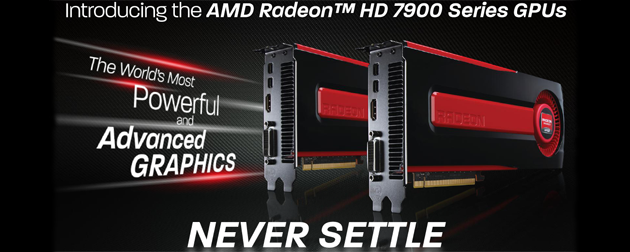
Today AMD announced the existence (and rapidly approaching release) of their latest flagship graphics card, the Radeon HD 7970, and it’s packed with a slew of new and improved technologies.
Here is what we know:
The Radeon HD 7970 uses the latest graphics architecture from AMD, dubbed Graphics Core Next (GCN), and is the first GPU built on 28nm production technology. The new and smaller technology allows for very high clock speeds and lower power usage at the same time. The core clock is set to 925MHz, although most (if not all) units should easily overclock to the 1GHz mark. During the conference call, the speaker reported his unit was currently running at 1.22GHz. 3GB of 1.375GHz GDDR5 is connected via 384-bit bus.
Four display connections will be available: two mini DisplayPorts, one HDMI 1.4 port, and one DVI port. All four are located along a single slot, leaving the second slot completely unobstructed for cooling. Despite the reduced number of output ports, AMD is making sure your multi-display setup won’t suffer: they’re including HDMI->DVI and active miniDP->DVI adapters with every card, so out of the box you’ll be able to run three non-DisplayPort monitors. Just like before, a total of six displays per GPU is supported.
The heatsink design has been tweaked slightly for improved cooling. The fan is now wider as are the blades, resulting in greater amounts of air circulation at lower RPM speeds. The max speed for the fan is now around 2000 RPM, lower than that of the 6900 series. To further improve cooling, the second DVI port was removed leaving the entire second slot unobstructed, reducing both temperature and noise levels.
The Radeon HD 7970 will be the first card to support the PCI Express 3.0 standard which provides 1Gb/s bandwidth per lane (16Gb/s for a 16x slot). It will retain backwards compatibility with both 1.0 and 2.0 standards, though a slight performance hit will occur during high data transfer rates.
Two PCI Express power cables will be required for the HD 7970: one six-pin and one eight-pin power connection will provide a maximum of 300W to the GPU. What’s interesting is the card, even under extreme loads, won’t use more than around 250W (I don’t recall the exact number…it was somewhere between 225-250W). So why not just put two six-pin power connectors on instead? That would be because…
New PowerTune
A refined version of PowerTune will debut with the new GPU, and this one is pretty interesting. Previous versions reduced performance as the power ceiling was reached, but did nothing if there was extra headroom. The version of PowerTune supported by the HD 7970 changes this. It will actually ramp up the clock speeds automatically when needed if its power draw will allow, similar to both AMD’s and Intel’s respective CPU ramping technologies.
On the opposite end of the spectrum is a new technology AMD calls ZeroCore Power. During long idle periods the Radeon HD 7970 can enter a very lower power state to conserve power. Should the display turn off due to power saving measures, the GPU will turn itself off, drawing less than 3W. When the GPU is needed, it can power back up within milliseconds. This technology also extends to other cards in a CrossFire configuration. Each card can power itself on or off independently as the situation demands.
Dual BIOS will make a return, allowing users to install a tweaked BIOS image while still having a backup plan that doesn’t involve buying another GPU.
Support for 16K displays is added. What are those? Well, basically it’s a freaking huge display. The Radeon HD 7970 supports displays up to 16,000 pixels wide by 16,000 pixels tall. With 4K displays right around the corner, an EyeFinity configuration that size display could easily be made in the near future.
Don’t forget the audio…
Perhaps one of the coolest new features doesn’t have as much to do with video as much as it does audio. Discrete Digital Multi-point Audio provides multiple independent audio streams for audio-capable displays using either HDMI or DisplayPort cables. Any audio stream coming from a video source on a particular display will play through that display’s speakers. Move the video? The audio follows.
With a list of qualifications like this, performance expectations are going to be very high, and AMD says those expectations should be met. For example, take Battlefield 3 and run it at Ultra settings at a resolution of 5760×1200 (that’s three 1920×1200 displays) EyeFinity setup. According to AMD a single Radeon HD 7970 will be able to handle this. Excited yet?
The Radeon HD 7970 officially launches today and will be available from retailers January 9 with select models starting at $549.
Some of the reviews from the web:















 Articles RSS
Articles RSS